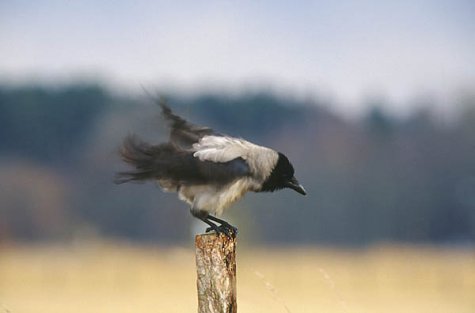Crows enliven the surroundings
Photo: Arne Ader
Crow on fence post
| Hooded crow |
Hallvares
|
Corvus corone |
It is more useful to mention the places where hooded crows do not live – massive forests and large expanses of marsh and bog. Even town people notice the daily doings of these familiar birds. In the morning the crows from a neighbourhood gather and socialise; after that all go foraging for food; midday is a time for rest and active birds are almost not to be seen. Evening flights start a couple of hours before sunset. In towns the night is spent in large deciduous trees in parks and cemeteries, in rural landscapes conifers that offer denser protection are more appreciated.
Are hooded crows sedentary, vagrant or migratory birds? In August the young crows become independent, and which way of life they choose depends partly on the company. Contradictory to common belief „old crows“ and inhabitants of forested areas are most given to roaming. Maybe to get some excitement in the monotony of country life? Young birds and city birds are more sedentary. For the city crows it is understandable: in the company of people their food supply is better assured.
In October migrants coming from the north and east are evident; they continue to come until the permanent winter cold sets in. The number of hooded crows in Estonia is estimated to be around a couple of hundred thousands up to four hunderd thousand birds.
The black-plumaged rooks shook the dust of the Estonian fields off their feet last week already.









